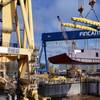US Navy Shibuilding Schedules Hit by Supply Chain Woes
Virginia-class submarines, an aircraft carrier and frigates being built for the U.S. Navy are now years behind schedule because of skilled labor shortages, design issues, and supply chain challenges stemming from the pandemic, the Navy said on Tuesday.
U.S. Navy Secretary Carlos Del Toro in January ordered a comprehensive review to examine national and local causes of the challenges to shipbuilding with Tuesday's results showing that five classes of ships being built for the U.S. Navy were running years behind schedule.
Shipyard labor retention remains a stubborn problem long after the end of the pandemic which led to high retirement rates for older and more skilled workers, Vice Admiral James Downeytold reporters at the Pentagon.
"We still have seen attrition continue in a negative direction in multiple regions, in some places its doubled from where it was at the beginning of the pandemic, in other cases it's more," Downey said.
The first ship in the new class of Frigate warships, being built at Fincantieri SpA's Marinette Marine shipyard in Marinette, Wisconsin, was about three years behind, as was the Virginia Class block IV submarine being built by General Dynamics and Huntington Ingalls Industries.
The Virginia block V, a related but separate design with more missile launch tubes, was two years behind, the Navy's assessment determined.
The Navy's Columbia Class submarine, capable of launching nuclear missiles, is 12-16 months behind schedule "based on current performance" by the contractors General Dynamics and Huntington.
The year-plus delay beyond a current October 2027 goal is forcing the Navy to examine extending the life of the Ohio Class of nuclear capable submarines, Navy officials told reporters at the Pentagon.
The Navy wants to maintain Columbia as a top priority because it is the launch platform for the sea-launched leg of the nuclear "triad" of nuclear-tipped weapons which also include ground-based inter-continental ballistic missiles and nuclear-capable bomber aircraft.
The Navy also said the Ford Class aircraft carrier, CVN 80, was running 18-26 months behind schedule, an estimate based on current performance. Previously it had been scheduled for delivery in 2028.
(Reuters - Reporting by Mike Stone; editing by Costas Pitas)















